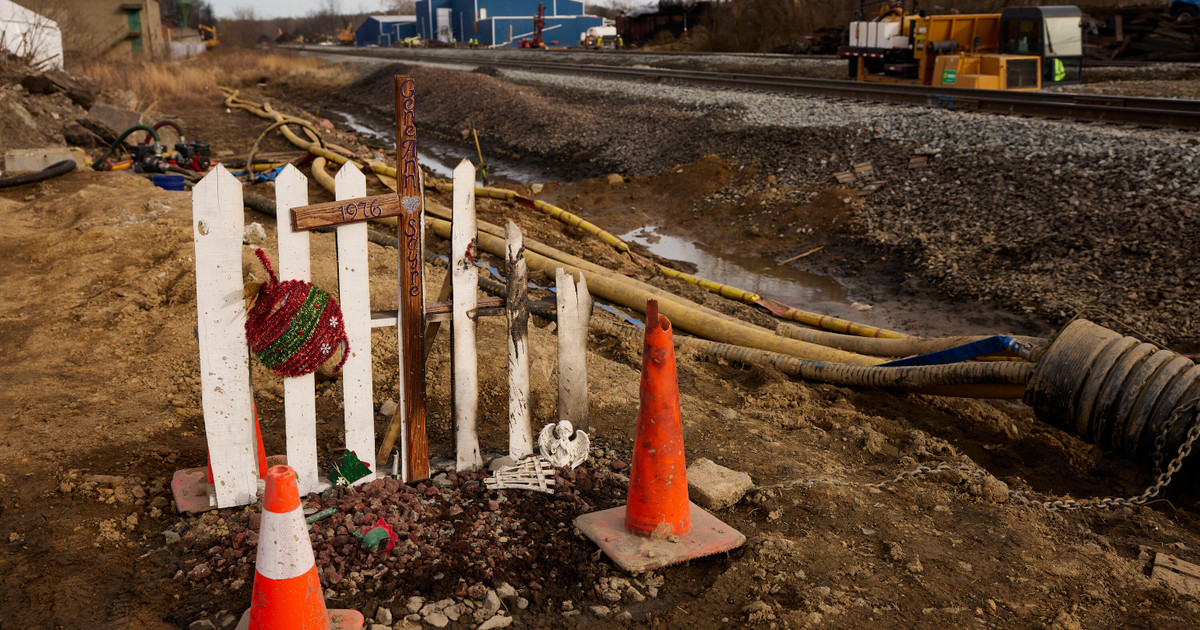Oddball
Unobtanium Member
- Jan 3, 2009
- 105,411
- 112,420
That phony canard was debunked a week ago, dipschitt.Oddball wants to dodge Trump's deregulation
You brought it up.by pretending we are talking about Communist China and Mussolini.
LOL..
Follow along with the video below to see how to install our site as a web app on your home screen.
Note: This feature may not be available in some browsers.
That phony canard was debunked a week ago, dipschitt.Oddball wants to dodge Trump's deregulation
You brought it up.by pretending we are talking about Communist China and Mussolini.
LOL..
LOL. While Biden and Pete Buttplug ignore the area.Trump's deregulatory actions are coming back to haunt him, as explained in this great Político analysis today:
Trump’s administration withdrew an Obama-era proposal to require faster brakes on trains carrying highly flammable materials, ended regular rail safety audits of railroads, and mothballed a pending rule requiring freight trains to have at least two crew members. He also placed a veteran of the chemical industry in charge of the Environmental Protection Agency’s chemical safety office, where she made industry-friendly changes to how the agency studied health risks.

Trump’s visit to Ohio derailment gives Biden’s team some breathing room
His planned appearance near the scene of this month’s toxic derailment has Democrats pointing to his past efforts to roll back train and chemical regulations.www.politico.com
Trump's deregulatory actions are coming back to haunt him, as explained in this great Político analysis today:
Trump’s administration withdrew an Obama-era proposal to require faster brakes on trains carrying highly flammable materials, ended regular rail safety audits of railroads, and mothballed a pending rule requiring freight trains to have at least two crew members. He also placed a veteran of the chemical industry in charge of the Environmental Protection Agency’s chemical safety office, where she made industry-friendly changes to how the agency studied health risks.

Trump’s visit to Ohio derailment gives Biden’s team some breathing room
His planned appearance near the scene of this month’s toxic derailment has Democrats pointing to his past efforts to roll back train and chemical regulations.www.politico.com
I guess they deregulated the southern border, too.And Trump isn’t alone.
This is consistent with Republicans’ reckless, irresponsible pursuit of meritless deregulation.
From a previous linked post, the ECP was still a requirement on cars carrying toxic materials. NTSB pointed out the ECP's on this train worked as required.Still waiting for a single person to conclusively show that the rollback of these regulations resulted in this accident. Nobody has done so as far as I know, but it hasn't stopped you Non-Player Characters from parroting the same talking point over and over because a partisan hack will hack.

It's disappointing that instead of addressing the real problem here - the Trump administration's rollback of important safety regulations - maybelooking is focusing instead on who visited the area first. This kind of deflection is exactly what allows politicians to get away with endangering the lives of the American people in pursuit of corporate interests. It's time to have a real conversation about the damage that has been done to our safety regulations under the previous administration and what we can do to fix it
And Trump isn’t alone.
This is consistent with Republicans’ reckless, irresponsible pursuit of meritless deregulation.
The Obama safety brake rule would not have applied as the train did not meet the "high-hazard flammable" threshold. A 'hot axle' was the root cause.
But NTSB Chair Jennifer Homendy said that the brake rule would not have prevented the accident because the train did not meet the "high-hazard flammable" threshold to require them
"Surveillance video from a residence showed what appears to be a wheel bearing in the final stage of overheat failure moments before the derailment,"

New details emerge about cause of Ohio train derailment
Residents have been waiting for details for weeks. Several federal organizations, including the NTSB and EPA, are conducting investigations into the incident.www.newsweek.com
I'd think any communications between crew and a help desk would be part of the records accessible during an accident investigation. If so, that's an issue for NS.Here is a report on an earlier derailment last year also caused by overheating wheel bearings, where railroad officials told the crew involved to ignore the sensors that detected the problem … just miles before a derailment caused by this overheated wheel occurred.
All this testifies to the laxness towards safety and regulation of U.S. railroads, lack of investment in new safety equipment, etc. It should be noted there are an average of 1,700 derailments every year in the U.S., mostly with far less catastrophic results than those of this Ohio event.

A Norfolk Southern Policy Lets Officials Order Crews to Ignore Safety Alerts
In October, months before the East Palestine derailment, the company also directed a train to keep moving with an overheated wheel that caused it to derail miles later in Sandusky, Ohio.www.propublica.org
The wheel bearing burned up. WTf would different brakes have done to prevent that?From a previous linked post, the ECP was still a requirement on cars carrying toxic materials. NTSB pointed out the ECP's on this train worked as required.
Possibly prevented the piling on into cars ahead.The wheel bearing burned up. WTf would different brakes have done to prevent that?
STOPPED the TRAIN, SOONER.The wheel bearing burned up. WTf would different brakes have done to prevent that?
No, it could have kept rear cars from piling into cars in front of each other, limiting the amount of derailment.STOPPED the TRAIN, SOONER.
You're FOS.No, it could have kept rear cars from piling into cars in front of each other, limiting the amount of derailment.
BTW- ECP's are unreliable.
As soon as air pressure is lost the brakes lock up. It wouldn’t have stopped anything faster.Possibly prevented the piling on into cars ahead.